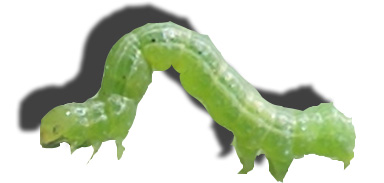
|
|
|
|

|
|||
|
|
|||
|
Historically, worms (Lepidopterous larvae; -beet armyworm, cabbage looper and corn
earworm) are the most important pests of desert pruduce during September and October.
So, it is no surprise that worms are everywhere particularly in Dome Valley where
heavy beet armyworm pressure has been reported over the past week or so. Many PCAs
have reported that armyworm have been infesting lettuce as early as 8 days after
wet date, which seems quicker than usual. Corn earworm larvae have also been reported
in a few fields. Here at the Yuma Ag Center, one can easily find newly new egg masses
and neonate beet armyworm larvae on 10 day old lettuce and broccoli stands. Cabbage
loopers are beginning to show up and their populations will likely increase. Remember,
temperatures drive larval development and adult moth activity, particularly when
night time temps remain high (in the mid-70s or higher). The moths are nocturnal
and will actively oviposit when evenings are warm and winds are light. With shorter
days coming, the moths have more time to lay eggs at night. As long as the average
temperature remains around 80-85°F, worms should be active at damaging levels. Those
ideal conditions are consistent with the weather forecast for the next 10 days (daytime
highs in the low 100’s and nighttime lows in the mid 70’s). Fortunately, there are
a number of very effective insecticides that can be applied as stand-alone foliar
products that provide effective residual control of both of these lepidopterous
species. Radiant, Proclaim, Intrepid, Avaunt and any one of the Diamide products
(Belt, Coragen, Exirell, Vetica, and Voliam Xpress) can provide good knockdown and
extended residual control of armyworms and loopers. Addition of a pyrethroid often
enhances knockdown of corn earworm and cabbage looper for many of the products.
Of course, residual control will often depend on the rate applied. In general, the
higher the rate, the longer the residual. But this will also depend on plant size
at time of application and how fast the plant is growing. Before selecting a product
for worm control, be conscious of products (chemistries) previously used on the
crop. Avoid using products with the same mode of action more than twice on any given
field. More information on the insecticides available for effective control of beet
armyworm and cabbage looper can be found in this document:
Lepidopterous Larvae Management in Desert Produce Crops, 2015..
Worms are everywhere!

Remember, When in Doubt . . . . . “SCOUT”
Click picture to listen to John’s update
To contact John Palumbo go to: jpalumbo@ag.arizona.edu |
|||
| Back | |||
|
For questions or comments on any of the topics please contact Marco Pena at the Yuma Agricultural Center.
|
|||
|
Home |
Cotton | Veggies |
Forages | Grains
| Citrus |
Crop x Crop Insects | Diseases| Weeds | Pesticides | Economics | News | Weather | Research | Photos | Contacts | General Info. Copyright © 2001 University of Arizona, College of Agriculture and Life Sciences Webmaster: Al Fournier (acis@ag.arizona.edu) |
|||
